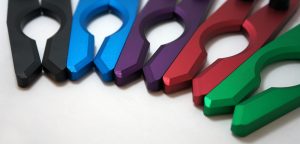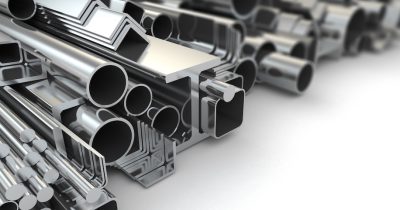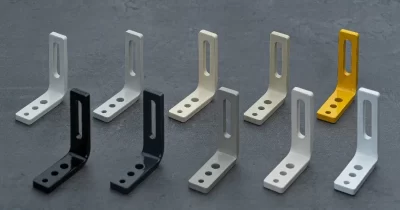Understanding Anodizing:
Benefits, Types, and Common Uses Explained

Anodizing, also known as alumite or anodic oxidation, is a surface treatment used to protect aluminum. It is so commonly applied to industrial aluminum products that it’s not an exaggeration to say almost all such products undergo this treatment. In this article, we will explain the characteristics, benefits, and drawbacks of anodizing.
Table of Contents
What is Anodizing?
While aluminum is generally considered a metal that doesn’t rust easily, it is actually quite reactive due to its high ionization tendency. It readily reacts with various chemicals, such as water and oxygen. aluminum reacts with oxygen to form a thin, stable oxide layer, known as alumina (Al2O3). This natural oxide layer protects the aluminum from further corrosion by resisting oxygen, liquids, and acids. Although this layer is effective, it’s only about 2 nanometers thick and can be easily scratched, offering limited protection. Metals that protect their internal structure with a naturally occurring surface layer are called passive metals.
Anodizing is a process used to enhance the durability of aluminum by immersing it in acidic solutions such as sulfuric acid, chromic acid, phosphoric acid, or oxalic acid to form a thick oxide layer on the surface of the aluminum.
By applying an electrical current with aluminum as the anode, an anodic oxide coating forms on the surface. This process, called anodizing or anodic oxidation, results in a much thicker oxide layer, ranging from 5 to 70 micrometers, featuring a honeycomb-like structure with hexagonal cells and pores.
Another characteristic of anodizing is that the growth of the oxide coating occurs in two directions: outward from the substrate’s surface and inward into the substrate. Therefore, When re-anodizing previously treated parts, the old layer must be removed, which reduces the substrate’s thickness and causes thinning. Additionally, because the anodizing layer expands outward, the dimensions of the part will increase. For instance, a standard clear anodizing process adds about 10 μm to the coating, causing an outward dimension expansion of approximately 5 μm.
In blind holes or threaded holes that do not go through, residual cutting oil may remain even after degreasing, which can cause the solution to spurt out during anodizing. Caution is needed in such cases.
Types of Anodizing
Anodizing can be categorized into several types based on color and finish. Here are three common types:
Clear Anodizing
This is the most common type of anodizing. While it doesn’t actually add color, it gives the aluminum a slightly dulled appearance. The coating thickness is typically around 10 μm.
Black Anodizing
Anodizing can be dyed in various colors, with black being one of the most commonly used colors. Black anodizing is a popular choice in colored anodizing.
Matte Anodizing
If the material undergoes blasting before anodizing, a matte finish can be achieved. This type of anodizing offers high decorative value and can be dyed in a range of colors beyond just white.
Advantages of Anodizing
Anodizing offers several benefits beyond just preventing the corrosion of aluminum.
Non-Delaminating
Unlike plating or painting, anodizing integrates with the substrate as it grows, so there’s no risk of it peeling off.
High Corrosion Resistance and Color Stability
The main component of anodizing, alumina (Al2O3), is chemically stable and doesn’t react easily with other substances. By sealing the microscopic pores formed on the oxide film, anodizing further enhances its corrosion resistance, making it less prone to discoloration and corrosion.
Very Hard and Abrasion-Resistant
While pure aluminum is relatively soft and prone to deformation, anodized aluminum becomes much harder due to the alumina layer, with hardness values ranging from HV200 to HV600. Hard anodizing, especially with a coating thickness exceeding 20 μm, can even surpass the hardness of stainless steel. This makes it particularly suitable for wear-resistant applications like shafts and other sliding parts.
Available in Various Colors and Aesthetically Pleasing
Anodized coatings feature regular, microscopic pores that can absorb dyes, allowing for a wide range of colors. Unlike paint, which covers the surface, anodizing imparts a metallic sheen to the surface and maintains its aesthetic appeal. The durability of the anodized layer also helps preserve the visual quality, making it ideal for decorative applications such as building exteriors and machinery housings.
High Insulation and Non-Conductive
The anodized alumina layer is electrically insulating, contrasting with the high conductivity of raw aluminum. This makes anodizing a good choice for applications requiring electrical insulation. If electrical conductivity is needed, the anodized layer can be removed by machine to expose the underlying material.
Low Thermal Conductivity but High Heat Dissipation
Anodizing provides low thermal conductivity and good thermal insulation. However, it has high emissivity for far-infrared radiation, making it effective for heat dissipation. This characteristic makes anodized aluminum popular for heat sinks and other thermal management components.
Disadvantages of Anodizing
While anodizing has many advantages, there are also some drawbacks and considerations to keep in mind.
Low Flexibility and Brittle
Anodized coatings are very hard but can be brittle. This means that machining or bending anodized parts can cause cracks or peeling. Ideally, all machining should be completed before anodizing. If working with anodized materials, be cautious to avoid damaging the coating.
Low Heat Resistance
Anodized layers can be susceptible to cracking or peeling when subjected to high temperatures, especially since aluminum expands and contracts with temperature changes. Although anodizing itself is stable, the properties of the underlying aluminum may cause issues in high-temperature environments. Therefore, anodizing is not recommended for applications with significant temperature fluctuations or high temperatures.
Common Applications of Anodizing
Anodizing is used in a variety of applications. Here are some typical examples:
- Kitchenware
Anodized aluminum is perfect for kitchen items like lunch boxes, kettles, and pots due to its resistance to corrosion and scratches. Traditional aluminum lunch boxes, kettles, and pots often feature anodized coatings. - Consumer Electronics
Anodizing is used for its attractive appearance and durability in electronics components, including smartphones. The decorative qualities of anodized finishes add value to electronic devices. - Building Materials
Anodizing is commonly used in building materials for its corrosion resistance and aesthetic appeal. You can find anodized products in items like carport columns, metal posts, and window frames. - Interior Parts for Trains and Aircraft
Lightweight components are crucial for improving fuel efficiency and energy savings in transportation. Anodized aluminum parts are widely used for this purpose. - Automotive Parts
Anodized aluminum is ideal for automotive components due to its corrosion resistance and abrasion resistance, especially for parts like wheels. - Optical Components
Anodizing offers high decorative value and can be dyed in various colors. Black anodizing is used in optical components to minimize light reflection. - Semiconductor Components
With its excellent insulation and heat dissipation properties, anodized aluminum is used in semiconductor components for electronic devices. - Lighting Fixtures
The high decorative quality and heat dissipation capabilities of anodized aluminum make it suitable for lighting fixtures, which often require both aesthetics and performance. - Medical Equipment
Medical equipment requires surfaces that are both hygienic and resistant to damage. Anodized aluminum’s durability, resistance to corrosion, and scratch resistance make it well-suited for such applications. - Nameplates and Decorative Panels
Anodizing is also ideal for nameplates and decorative panels, where various colors and finishes are required.
These examples represent just a fraction of the applications for anodized aluminum. Most aluminum products in common use today are likely to have undergone anodizing.
Conclusion
Anodizing is a surface treatment for aluminum that forms an oxide coating through an electrochemical process. The resulting coating, composed primarily of alumina, is resistant to corrosion and highly durable. Anodizing is also versatile in terms of color and aesthetics, making it suitable for a wide range of applications. However, it is important to consider its limitations, such as brittleness and low heat resistance. Anodizing is widely used in various industries and applications.
What’s meviy?
On-demand, fast sourcing of quality custom mechanical parts is made possible by meviy.
meviy is one of the most reliable on-demand manufacturing platforms in the US that allows you to get instant quotes for your mechanical parts simply by uploading 3D CAD data. No longer need to create 2D drawings just to quote parts. This platform supports sheet metal fabrication and CNC machining such as milling or turning and has saved time for over 160,000 mechanical designers and purchasers worldwide.






